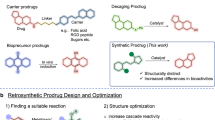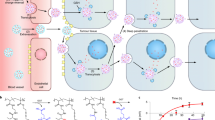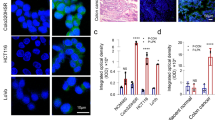Abstract
CPT-11 is a potent antitumor agent that is activated by carboxylesterases (CE) and intracellular expression of CEs that can activate the drug results in increased cytotoxicity to the drug. As activation of CPT-11 (irinotecan-7-ethyl-10-[4-(1-piperidino)-1-piperidino]carbonyloxycamptothecin) by human CEs is relatively inefficient, we have developed enzyme/prodrug therapy approaches based on the CE/CPT-11 combination using a rabbit liver CE (rCE). However, the in vivo application of this technology may be hampered by the development of an immune response to rCE. Therefore, we have developed a mutant human CE (hCE1m6), based on the human liver CE hCE1, that can activate CPT-11 approximately 70-fold more efficiently than the wild-type protein and can be expressed at high levels in mammalian cells. Indeed, adenoviral-mediated delivery of hCE1m6 with human tumor cells resulted in up to a 670-fold reduction in the IC50 value for CPT-11, as compared to cells transduced with vector control virus. Furthermore, xenograft studies with human tumors expressing hCE1m6 confirm the ability of this enzyme to activate CPT-11 in vivo and induce antitumor activity. We propose that this enzyme should likely be less immunogenic than rCE and would be suitable for the in vivo application of CE/CPT-11 enzyme/prodrug therapy.
This is a preview of subscription content, access via your institution
Access options
Subscribe to this journal
Receive 12 print issues and online access
$259.00 per year
only $21.58 per issue
Buy this article
- Purchase on Springer Link
- Instant access to full article PDF
Prices may be subject to local taxes which are calculated during checkout



Similar content being viewed by others
Accession codes
Abbreviations
- CE:
-
carboxylesterase
- CPT-11:
-
irinotecan,7-ethyl-10-[4-(1-piperidino)-1-piperidino]carbonyloxycamptothecin
- hCE1:
-
human carboxylesterase 1
- hCE1m6:
-
hCE1 containing 8 site specific mutations
- hiCE:
-
human intestinal carboxylesterase
- IC50:
-
the concentration of drug that produced a 50% inhibition of cell growth
- rCE:
-
rabbit liver carboxylesterase
- SN-38:
-
7-ethyl-10-hydroxycamptothecin
References
Cashman J, Perroti B, Berkman C, Lin J . Pharmacokinetics and molecular detoxification. Environ Health Perspect 1996; 104: 23–40.
Tanizawa A, Fujimori A, Fujimori Y, Pommier Y . Comparison of topoisomerase I inhibition, DNA damage, and cytotoxicity of camptothecin derivatives presently in clinical trials. J Natl Cancer Inst 1994; 86: 836–842.
Furman WL, Stewart CF, Poquette CA, Pratt CB, Santana VM, Zamboni WC et al. Direct translation of a protracted irinotecan schedule from a xenograft model to a Phase I trial in children. J Clin Oncol 1999; 17: 1815–1824.
Houghton JA, Cheshire PJ, Hallman JA, Lutz L, Luo X, Li Y et al. Evaluation of irinotecan in combination with 5-fluorouracil or etoposide in xenograft models of colon adenocarcinoma and rhabdomyosarcoma. Clin Cancer Res 1996; 2: 107–118.
Houghton PJ, Cheshire PJ, Hallman II JD, Lutz L, Friedman HS, Danks MK et al. Efficacy of topoisomerase I inhibitors, topotecan and irinotecan, administered at low dose levels in protracted schedules to mice bearing xenografts of human tumors. Cancer Chemother Pharmacol 1995; 36: 393–403.
Morton CL, Iacono L, Hyatt JL, Taylor KR, Cheshire PJ, Houghton PJ et al. Metabolism and antitumor activity of CPT-11 in plasma esterase-deficient mice. Cancer Chemother Pharmacol 2005; 56: 629–636.
Morton CL, Taylor KR, Iacono L, Cheshire P, Houghton PJ, Danks MK et al. Metabolism of CPT-11 in esterase deficient mice. Proc Am Assoc Cancer Res 2002; 43: 248.
Danks MK, Morton CL, Krull EJ, Cheshire PJ, Richmond LB, Naeve CW et al. Comparison of activation of CPT-11 by rabbit and human carboxylesterases for use in enzyme/prodrug therapy. Clin Cancer Res 1999; 5: 917–924.
Meck M, Wierdl M, Wagner L, Burger R, Harris LC, Potter PM et al. A VDEPT approach to purging neuroblastoma cells from hematopoeitic cells using adenovirus encoding rabbit carboxylesterase and CPT-11. Cancer Res 2001; 61: 5083–5089.
Potter PM, Pawlik CA, Morton CL, Naeve CW, Danks MK . Isolation and partial characterization of a cDNA encoding a rabbit liver carboxylesterase that activates the prodrug irinotecan (CPT-11). Cancer Res 1998; 52: 2646–2651.
Wagner LM, Guichard SM, Burger RA, Morton CL, Straign CM, Ashmun RA et al. Efficacy and toxicity of a virus-directed enzyme prodrug therapy purging method: preclinical assessment and application to bone marrow samples from neuroblastoma patients. Cancer Res 2002; 62: 5001–5007.
Wierdl M, Morton CL, Weeks JK, Danks MK, Harris LC, Potter PM . Sensitization of human tumor cells to CPT-11 via adenoviral-mediated delivery of a rabbit liver carboxylesterase. Cancer Res 2001; 61: 5078–5082.
Aboody KS, Bush RA, Garcia E, Metz M, Najbauer J, Justus KA et al. Development of a tumor-selective approach to treat metastatic cancer. PLoS ONE 2006; 1: 1–10.
Danks MK, Yoon KJ, Bush RA, Remack JS, Wierdl M, Tsurkan L et al. Tumor-targeted enzyme/prodrug therapy mediates long-term disease-free survival of mice bearing disseminated neuroblastoma. Cancer Res 2007; 67: 22–25.
Humerickhouse R, Lohrbach K, Li L, Bosron W, Dolan M . Characterization of CPT-11 hydrolysis by human liver carboxylesterase isoforms hCE-1 and hCE-2. Cancer Res 2000; 60: 1189–1192.
Khanna R, Morton CL, Danks MK, Potter PM . Proficient metabolism of CPT-11 by a human intestinal carboxylesterase. Cancer Res 2000; 60: 4725–4728.
Oosterhoff D, Overmeer RM, de Graaf M, van der Meulen IH, Giaccone G, van Beusechem VW et al. Adenoviral vector-mediated expression of a gene encoding secreted, EpCAM-targeted carboxylesterase-2 sensitises colon cancer spheroids to CPT-11. Br J Cancer 2005; 92: 882–887.
Oosterhoff D, Pinedo HM, van der Meulen IH, de Graaf M, Sone T, Kruyt FA et al. Secreted and tumour targeted human carboxylesterase for activation of irinotecan. Br J Cancer 2002; 87: 659–664.
Oosterhoff D, Pinedo HM, Witlox MA, Carette JE, Gerritsen WR, van Beusechem VW . Gene-directed enzyme prodrug therapy with carboxylesterase enhances the anticancer efficacy of the conditionally replicating adenovirus AdDelta24. Gene Ther 2005; 12: 1011–1018.
Oosterhoff D, Witlox MA, van Beusechem VW, Haisma HJ, Schaap GR, Bras J et al. Gene-directed enzyme prodrug therapy for osteosarcoma: sensitization to CPT-11 in vitro and in vivo by adenoviral delivery of a gene encoding secreted carboxylesterase-2. Mol Cancer Ther 2003; 2: 765–771.
Bencharit S, Morton CL, Howard-Williams EL, Danks MK, Potter PM, Redinbo MR . Structural insights into CPT-11 activation by mammalian carboxylesterases. Nat Struct Biol 2002; 9: 337–342.
Bencharit S, Morton CL, Hyatt JL, Kuhn P, Danks MK, Potter PM et al. Crystal structure of human carboxylesterase 1 complexed with the Alzheimer's drug tacrine. From binding promiscuity to selective inhibition. Chem Biol 2003; 10: 341–349.
Munger JS, Shi GP, Mark EA, Chin DT, Gerard C, Chapman HA . A serine esterase released by human alveolar macrophages is closely related to liver microsomal carboxylesterases. J Biol Chem 1991; 266: 18832–18838.
Schwer H, Langmann T, Daig R, Becker A, Aslanidis C, Schmitz G . Molecular cloning and characterization of a novel putative carboxylesterase, present in human intestine and liver. Biochem Biophys Res Commun 1997; 233: 117–120.
Douglass EC, Valentine M, Etcubanas E, Parham D, Webber BL, Houghton PJ et al. A specific chromosomal abnormality in rhabdomyosarcoma. Cytogenet Cell Genet 1987; 45: 148–155.
Bencharit S, Morton CL, Xue Y, Potter PM, Redinbo MR . Structural basis of heroin and cocaine metabolism by a promiscuous human drug-processing enzyme. Nat Struct Biol 2003; 10: 349–356.
Beaufay H, Amar-Costesec A, Feytmans E, Thines-Sempoux D, Wibo M, Robbi M et al. Analytical study of microsomes and isolated subcellular membranes from rat liver. I. Biochemical methods. J Cell Biol 1974; 61: 188–200.
Guichard S, Morton CL, Krull EJ, Stewart CF, Danks MK, Potter PM . Conversion of the CPT-11 metabolite APC to SN-38 by rabbit liver carboxylesterase. Clin Cancer Res 1998; 4: 3089–3094.
Morton CL, Wierdl M, Oliver L, Ma M, Danks MK, Stewart CF et al. Activation of CPT-11 in mice: identification and analysis of a highly effective plasma esterase. Cancer Res 2000; 60: 4206–4210.
Morton CL, Potter PM . Comparison of Escherichia coli, Saccharomyces cerevisiae, Pichia pastoris, Spodoptera frugiperda and COS7 cells for recombinant gene expression: application to a rabbit liver carboxylesterase. Mol Biotechnol 2000; 16: 193–202.
Wadkins RM, Morton CL, Weeks JK, Oliver L, Wierdl M, Danks MK et al. Structural constraints affect the metabolism of 7-ethyl-10-[4-(1-piperidino)-1-piperidino]carbonyloxycamptothecin (CPT-11) by carboxylesterases. Mol Pharmacol 2001; 60: 355–362.
Matsuidaira P . Limited N-terminal sequence analysis. Methods Enzymol 1990; 182: 602–613.
Morton CL, Potter PM . Rhabdomyosarcoma-specific expression of the Herpes simplex virus thymidine kinase gene confers sensitivity to ganciclovir. J Pharmacol Exp Ther 1998; 286: 1066–1073.
Wierdl M, Morton CL, Nguyen NK, Redinbo MR, Potter PM . Molecular modeling of CPT-11 metabolism by carboxylesterases (CEs): use of pnb CE as a model. Biochemistry 2004; 43: 1874–1882.
Aharoni A, Gaidukov L, Yagur S, Toker L, Silman I, Tawfik DS . Directed evolution of mammalian paraoxonases PON1 and PON3 for bacterial expression and catalytic specialization. Proc Natl Acad Sci 2004; 101: 482–487.
Reyes-Duarte D, Polaina J, Lopez-Cortes N, Alcalde M, Plou FJ, Elborough K et al. Conversion of a carboxylesterase into a triacylglycerol lipase by a random mutation. Angew Chem Int Ed Engl 2005; 44: 7553–7557.
Potter PM, Wadkins RM . Carboxylesterases—detoxifying enzymes and targets for drug therapy. Curr Med Chem 2006; 13: 1045–1054.
Acknowledgements
We thank Dr J Patrick McGovren for the gift of CPT-11 and Dr Randy M Wadkins for suggesting the idea of loop replacement between the two CE proteins. This work was supported in part by NIH Grants CA76202 (PMP), CA79763 (MKD), CA98468 (MRR), CA108775 (PMP), DA18116 (PMP), CA23099 (PJH), a Cancer Center Core Grant P30 CA 21765 and by the American Lebanese Syrian Associated Charities.
Author information
Authors and Affiliations
Corresponding author
Rights and permissions
About this article
Cite this article
Wierdl, M., Tsurkan, L., Hyatt, J. et al. An improved human carboxylesterase for enzyme/prodrug therapy with CPT-11. Cancer Gene Ther 15, 183–192 (2008). https://doi.org/10.1038/sj.cgt.7701112
Received:
Revised:
Accepted:
Published:
Issue Date:
DOI: https://doi.org/10.1038/sj.cgt.7701112
Keywords
This article is cited by
-
Enzyme/Prodrug Systems for Cancer Gene Therapy
Current Pharmacology Reports (2016)
-
Global and local molecular dynamics of a bacterial carboxylesterase provide insight into its catalytic mechanism
Journal of Molecular Modeling (2012)
-
Enhancement of CPT-11 antitumor activity by adenovirus-mediated expression of β–glucuronidase in tumors
Cancer Gene Therapy (2011)
-
Therapeutic targeting of subdural medulloblastomas using human neural stem cells expressing carboxylesterase
Cancer Gene Therapy (2011)
-
Stem and progenitor cell-mediated tumor selective gene therapy
Gene Therapy (2008)



